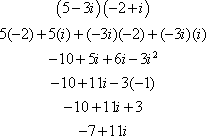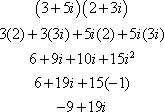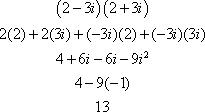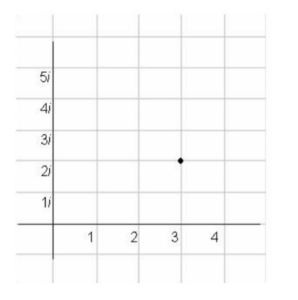 username@email.com
username@email.com
In this lesson you will study how to graph complex numbers in the plane and perform operations with complex numbers.
What are complex numbers?
An imaginary number is the square root of a negative number. A complex number is the field of numbers in the form ![]() , which is called the standard form of the complex number, where a and b are real numbers and i is an imaginary number equal to
, which is called the standard form of the complex number, where a and b are real numbers and i is an imaginary number equal to ![]() . In the standard form of the complex number, a is the real part of the complex number and bi is the imaginary part.
. In the standard form of the complex number, a is the real part of the complex number and bi is the imaginary part.
A conjugate is created by changing the sign of the imaginary part of a complex number.
How do I perform operations with complex numbers?
We will study four operations with complex numbers:
(1) addition,
(2) subtraction,
(3) multiplication, and
(4) division.
First Operation—Addition
To add complex numbers, add the real parts and then add the imaginary parts. For example,
![]()
Which choice shows the correct simplification of ![]() ?
?
The correct answer is D. To simplify, add the real parts, add the imaginary parts and then combine both parts.
![]()
Second Operation—Subtraction
Subtraction works in much the same way as addition. To simplify, subtract the real parts, and then subtract the imaginary parts. For example,
![]()
Which choice shows the correct result of subtracting ![]() ?
?
The correct answer is A. To simplify, subtract the real parts, subtract the imaginary parts, and then combine the two.
![]()
Multiplication can be done using the FOIL method discussed earlier. For example,
![]()
Mathematically ![]() , so
, so ![]() . Combine like terms for a final answer of
. Combine like terms for a final answer of ![]() .
.
It’s helpful to memorize the following:
![]()
Which choice shows the correct simplification of ![]() ?
?
The correct answer is B. To simplify, use the FOIL method.

Fourth Operation—Division
To divide complex numbers, multiply by the conjugate of the denominator. For example, divide ![]() . The conjugate of the denominator is
. The conjugate of the denominator is ![]() . Multiply the numerator and denominator by the conjugate, which will guarantee that you are multiplying by a form of one and not changing the value of the expression, to get
. Multiply the numerator and denominator by the conjugate, which will guarantee that you are multiplying by a form of one and not changing the value of the expression, to get ![]() . Use the FOIL method to multiply the numerators.
. Use the FOIL method to multiply the numerators.

Then use the FOIL method to multiply the denominators.

Finally, write the numerator over the denominator.
![]()
Which choice shows the correct simplification of ![]() ?
?
The correct answer is A. To simplify, multiply the numerator and denominator by the conjugate, ![]() .
.


Finally, place the numerator over the denominator.
![]()
Each point (a, b) represents the complex number ![]() in the complex plane. The real axis is the horizontal axis and the imaginary axis is the vertical axis. For example, to plot the point
in the complex plane. The real axis is the horizontal axis and the imaginary axis is the vertical axis. For example, to plot the point ![]() , move 3 right and 2 up from the origin.
, move 3 right and 2 up from the origin.

The correct answer is A. The real number axis is the horizontal axis and the imaginary axis is the vertical axis. The point shown is ![]() .
.